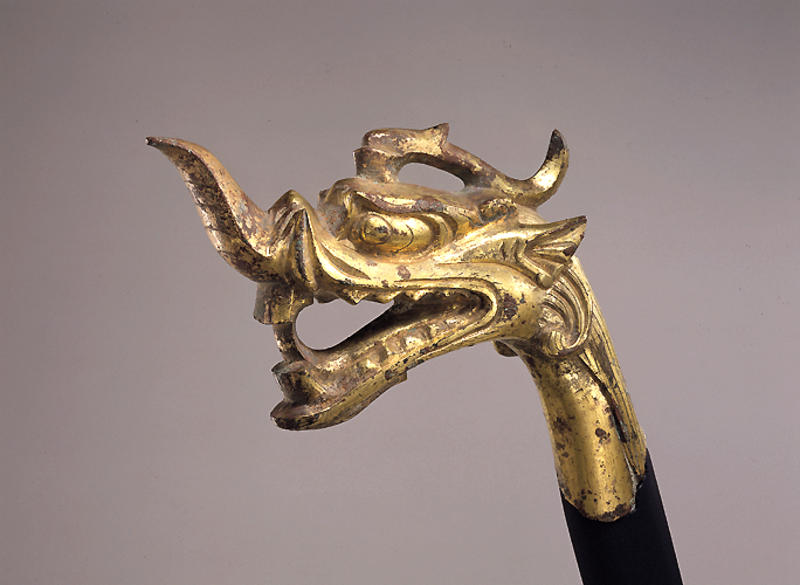Dragon-head Finial
- China
- China, Six Dynasties period
- 6th century
- Gilt bronze
- H-16.8 D-19 W-4.8
Catalogue Entry
Dragons have a long history as one of the most significant creatures in the Chinese mythological pantheon. Dragon heads often appeared as banner holders in ancient Chinese rituals. A funerary banner holder with a finial quite similar to the Shumei example was recently excavated in Beipiao, Liaoning province, from a tomb dated A.D. 415.1
The dragon head adorning this finial is typically Chinese. The long, tapered snout that is pushed up at the sides by fangs, the open jaws, curled-up tongue, bulging eyes, single S-shaped horn, and jaw spiral have defined early Chinese dragon images since the Han dynasty (206 B.C.-A.D. 220).
The finial is hollow and was cast by the lost-wax process. Inside is a copper sleeve. Its purpose is not clear; it could have been the sleeve into which a pole of some type, or the broken remains of such a pole, was inserted. An empty pear-shaped cell that may once have been inlaid adorns the back of the dragon's head.
The jaw spiral, represented by a three-stranded lock of hair that curls forward under the ear toward the base of the lower jaw, is a very specific stylistic trait found on almost all early Chinese dragon images, for example a Han gilt-bronze dragon excavated in Xi'an,2 a Tang-period walking dragon excavated at the Daming Palace in Xi'an,3 and the dragons depicted on the balustrade from the Zhaozhou Bridge, carved over a period of time from the late sixth to the twelfth century A.D.4 The Daming Palace dragon image has a single horn, as does the Shumei dragon. These comparative examples should be sufficient to dismiss the recent suggestion that the Shumei finial was made in Korea.5 None of the Korean examples cited has a jaw spiral or the same sinuous appearance as the Shumei example.
ECB
1. Xu and Sun 1996, fig. 171.
2. Osaka 1987, no. 109.
3. Sichuan sheng bowuguan et al. 1993, no. 46.
4. Yu 1956, figs. 5-6, 10, 12, 14, 16. I am very grateful to Hajime Inagaki for this reference.
5. Metropolitan Museum 1996, p. 140.
